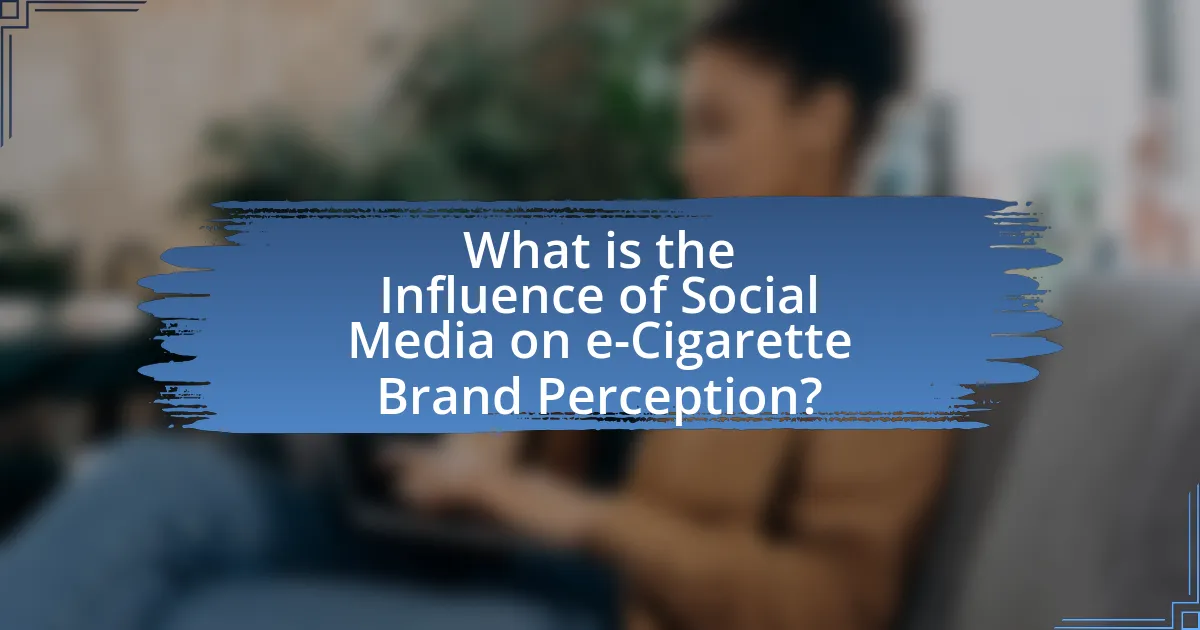The article examines the influence of social media on e-cigarette brand perception, highlighting how platforms like Instagram and Twitter shape consumer attitudes and behaviors through targeted marketing and peer interactions. It discusses the role of influencers, user-generated content, and visual appeal in enhancing brand visibility and engagement, particularly among younger demographics. Additionally, the article addresses the regulatory challenges e-cigarette brands face on social media, the potential risks associated with negative feedback, and the strategies successful brands employ to foster loyalty and trust. Overall, it underscores the critical importance of social media in shaping brand perception and consumer choices in the e-cigarette market.

What is the Influence of Social Media on e-Cigarette Brand Perception?
Social media significantly influences e-cigarette brand perception by shaping consumer attitudes and behaviors through targeted marketing and peer interactions. Research indicates that platforms like Instagram and Twitter facilitate brand engagement, where users share experiences and opinions, thereby affecting the perceived credibility and attractiveness of e-cigarette brands. A study published in the journal Tobacco Control found that social media exposure to e-cigarette content is associated with increased likelihood of e-cigarette use among adolescents, highlighting the powerful role of social media in shaping brand perception and consumer choices in this market.
How does social media shape consumer perceptions of e-cigarette brands?
Social media significantly shapes consumer perceptions of e-cigarette brands by influencing brand visibility, engagement, and consumer sentiment. Platforms like Instagram and Twitter allow brands to showcase their products through visually appealing content and user-generated posts, which can enhance brand image and attract new customers. Research indicates that 70% of young adults are influenced by social media when making purchasing decisions, highlighting the platform’s role in shaping perceptions. Additionally, social media facilitates direct interaction between brands and consumers, allowing for real-time feedback and community building, which can further enhance brand loyalty and trust.
What role do influencers play in shaping brand perception?
Influencers significantly shape brand perception by leveraging their credibility and reach to create authentic connections with their audience. Their endorsements can enhance brand visibility and foster trust, as consumers often view influencers as relatable figures rather than traditional advertisements. Research indicates that 49% of consumers depend on influencer recommendations for their purchasing decisions, highlighting the impact influencers have on shaping perceptions of brands, including e-cigarette brands. This influence is particularly pronounced in social media environments, where influencers can engage directly with followers, providing personalized experiences that traditional marketing cannot replicate.
How do user-generated content and reviews impact brand image?
User-generated content and reviews significantly shape brand image by influencing consumer perceptions and trust. Positive reviews and authentic user-generated content enhance brand credibility, leading to increased customer loyalty and purchase intentions. According to a study by BrightLocal, 79% of consumers trust online reviews as much as personal recommendations, demonstrating the powerful role of user feedback in shaping brand reputation. Conversely, negative reviews can damage brand image, as 94% of consumers report avoiding a business after reading a negative review, highlighting the critical impact of user-generated content on brand perception.
Why is social media a critical platform for e-cigarette marketing?
Social media is a critical platform for e-cigarette marketing because it allows brands to reach a vast audience quickly and engage with consumers directly. The interactive nature of social media facilitates brand loyalty and community building, which is essential for e-cigarette companies aiming to establish a strong market presence. According to a study published in the journal Tobacco Control, social media platforms significantly influence young adults’ perceptions of e-cigarettes, with 80% of users reporting exposure to e-cigarette marketing on these platforms. This high level of engagement and visibility underscores the importance of social media in shaping brand perception and consumer behavior in the e-cigarette market.
What demographic trends are evident in social media usage among e-cigarette consumers?
E-cigarette consumers predominantly consist of younger demographics, particularly individuals aged 18 to 24, who exhibit higher engagement on social media platforms. Research indicates that this age group is more likely to use platforms like Instagram and TikTok, where visual content and peer influence play significant roles in shaping brand perception. Additionally, studies show that e-cigarette consumers are more likely to follow brands and influencers on social media, with 70% of users reporting that social media influences their purchasing decisions. This trend highlights the importance of targeted marketing strategies aimed at younger audiences to effectively reach and engage e-cigarette consumers.
How does the visual nature of social media affect brand engagement?
The visual nature of social media significantly enhances brand engagement by capturing user attention more effectively than text-based content. Research indicates that posts with images receive 94% more views than those without, leading to higher interaction rates. This visual appeal encourages users to share content, thereby increasing brand visibility and fostering community engagement. Furthermore, platforms like Instagram and Pinterest, which prioritize visuals, have shown that brands utilizing high-quality images can achieve up to a 650% increase in engagement compared to those that do not. This demonstrates that the integration of compelling visuals is crucial for brands aiming to connect with their audience in the competitive landscape of social media.
What are the potential risks associated with social media marketing for e-cigarette brands?
The potential risks associated with social media marketing for e-cigarette brands include regulatory scrutiny, brand reputation damage, and targeting underage audiences. Regulatory scrutiny arises because many countries have strict advertising laws for tobacco and nicotine products, which can lead to legal penalties if violated. Brand reputation damage can occur due to negative public perception, especially as health concerns about vaping continue to rise; for instance, a 2020 study published in the Journal of Adolescent Health indicated that increased visibility of e-cigarette marketing correlates with heightened concerns about youth vaping. Additionally, social media platforms may inadvertently expose e-cigarette advertisements to underage users, leading to ethical dilemmas and potential backlash from advocacy groups focused on youth smoking prevention.
How can negative feedback on social media influence brand reputation?
Negative feedback on social media can significantly damage brand reputation by amplifying customer dissatisfaction and eroding trust. When consumers share negative experiences publicly, it can lead to a rapid spread of unfavorable perceptions, as studies indicate that 70% of consumers trust online reviews as much as personal recommendations. This negative sentiment can deter potential customers, as 86% of consumers hesitate to purchase from brands with negative reviews. Furthermore, the visibility of negative feedback can prompt existing customers to reconsider their loyalty, leading to decreased sales and a tarnished brand image.
What regulatory challenges do e-cigarette brands face on social media platforms?
E-cigarette brands face significant regulatory challenges on social media platforms, primarily due to strict advertising restrictions imposed by various governments. These regulations often limit the promotion of tobacco products, including e-cigarettes, to prevent youth exposure and discourage smoking. For instance, the U.S. Food and Drug Administration (FDA) enforces guidelines that prohibit the marketing of e-cigarettes to minors, which directly impacts how brands can engage with audiences on platforms like Instagram and Facebook. Additionally, many social media platforms have their own policies that restrict or ban the advertisement of tobacco-related products, further complicating e-cigarette brands’ ability to reach potential customers. These challenges necessitate careful navigation of both legal requirements and platform-specific rules to avoid penalties and ensure compliance.
How does social media engagement differ among various e-cigarette brands?
Social media engagement varies significantly among e-cigarette brands, with some brands achieving higher interaction rates due to targeted marketing strategies and audience demographics. For instance, brands like JUUL and Vuse have leveraged platforms like Instagram and TikTok to create visually appealing content that resonates with younger audiences, resulting in higher engagement metrics such as likes, shares, and comments. In contrast, other brands may focus on educational content or community-building efforts, which can lead to different types of engagement, such as discussions and shares among niche groups. Research indicates that brands with a strong influencer partnership tend to see a 30% increase in engagement compared to those without, highlighting the impact of strategic social media use on brand perception and consumer interaction.
What strategies do successful e-cigarette brands use on social media?
Successful e-cigarette brands utilize targeted advertising, influencer partnerships, and user-generated content strategies on social media. Targeted advertising allows brands to reach specific demographics, enhancing engagement; for instance, brands often use data analytics to tailor their ads to age groups most likely to use e-cigarettes. Influencer partnerships leverage the credibility and reach of popular figures in the vaping community, which can significantly boost brand visibility and trust. User-generated content encourages customers to share their experiences, creating a community around the brand and fostering loyalty. These strategies collectively enhance brand perception and consumer engagement in a competitive market.
How do brand narratives on social media affect consumer loyalty?
Brand narratives on social media significantly enhance consumer loyalty by creating emotional connections and fostering community engagement. When brands share authentic stories that resonate with their audience, they cultivate trust and relatability, which are crucial for loyalty. Research indicates that 64% of consumers are more likely to buy from a brand that shares their values, highlighting the importance of narrative alignment. Additionally, consistent and engaging brand narratives can lead to increased customer retention, as consumers feel a sense of belonging and identification with the brand. This connection is particularly vital in the e-cigarette market, where brand perception is heavily influenced by social media interactions and community feedback.
What insights can be drawn from the influence of social media on e-cigarette brand perception?
Social media significantly shapes e-cigarette brand perception by amplifying brand visibility and influencing consumer attitudes. Research indicates that platforms like Instagram and Twitter serve as key channels for e-cigarette marketing, where brands engage with users through targeted content and influencer partnerships. A study published in the journal Tobacco Control found that e-cigarette brands with a strong social media presence are perceived as more appealing and trendy, particularly among younger demographics. This perception is reinforced by user-generated content, which often portrays e-cigarettes in a positive light, further enhancing brand desirability.
How can e-cigarette brands leverage social media for better brand perception?
E-cigarette brands can leverage social media to enhance brand perception by engaging with their audience through authentic content and community-building initiatives. By creating relatable and informative posts, brands can foster a sense of trust and loyalty among consumers. For instance, a study published in the journal Tobacco Control found that brands that actively engage with users on platforms like Instagram and Facebook see a significant increase in positive brand sentiment. Additionally, utilizing user-generated content and testimonials can further enhance credibility, as consumers often trust peer recommendations over traditional advertising.
What best practices should e-cigarette brands follow in their social media strategies?
E-cigarette brands should prioritize transparency, compliance with regulations, and audience engagement in their social media strategies. Transparency involves openly sharing product information and health-related data, which builds trust with consumers. Compliance with regulations, such as age restrictions and advertising guidelines, is crucial to avoid legal repercussions and maintain brand integrity. Engaging with the audience through interactive content, responding to inquiries, and fostering community discussions enhances brand loyalty and perception. Research indicates that brands that actively engage with their audience on social media can improve customer satisfaction and brand reputation, as seen in studies analyzing consumer behavior in the vaping industry.


